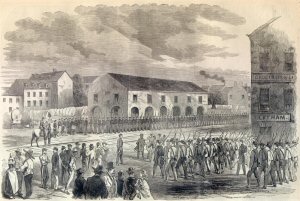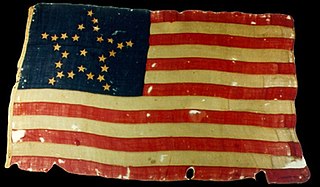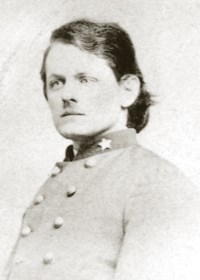
Turner Ashby Jr. was an American officer. He was a Confederate cavalry commander in the American Civil War.

The First Battle of Kernstown was fought on March 23, 1862, in Frederick County and Winchester, Virginia, the opening battle of Confederate Maj. Gen. Thomas J. "Stonewall" Jackson's campaign through the Shenandoah Valley during the American Civil War.
The Stonewall Brigade of the Confederate Army during the American Civil War, was a famous combat unit in United States military history. It was trained and first led by General Thomas J. "Stonewall" Jackson, a professor from Virginia Military Institute (VMI). His severe training program and ascetic standards of military discipline turned enthusiastic but raw recruits into an effective military organization, which distinguished itself from the First Battle of Bull Run in 1861 to Spotsylvania Court House in 1864. Its legacy lives on in the 116th Infantry Brigade, which bears the unofficial nickname "Stonewall Brigade," and in several living history reenactment groups.

The Army of the Shenandoah was a field army of the Confederate States Army active during the American Civil War. It was created to defend the Shenandoah Valley of Virginia from Union Army attacks during the early months of the war. The army was transferred to reinforce the Confederate Army of the Potomac at the First Battle of Bull Run, which was the only major engagement of the war it participated in. After the battle, the army was merged into the Army of the Potomac.

The 33rd Virginia Infantry Regiment was an infantry regiment raised in the Commonwealth of Virginia for service in the Confederate States Army during the American Civil War. It was a part of the famed "Stonewall Brigade," named for General Stonewall Jackson.
Company D, 2nd Virginia Infantry, locally designated the Berkeley Border Guards, was an antebellum Virginia militia company and then a company of the 2nd Virginia Infantry, a Confederate infantry unit during the American Civil War.

The 7th Ohio Infantry Regiment was an infantry regiment formed in northeastern Ohio for service in the Union Army during the American Civil War. It served in the Eastern Theater in a number of campaigns and battles with the Army of Virginia and the Army of the Potomac, and was then transferred to the Western Theater, where it joined the Army of the Cumberland besieged at Chattanooga. It was noted for its holding the high ground at the center of the line at Antietam as part of Tyndale's 1st Brigade, Greene's 2nd Division of Mansfield's XII Corps. It is of the 7th regiment that a war historian wrote, "All in all, considering the number of its battles, its marches, its losses, its conduct in action, it may be safely said that not a single regiment in the United States gained more lasting honor or deserved better of its country than the Seventh Ohio Volunteer Infantry."

The city of Winchester, Virginia, and the surrounding area, were the site of numerous battles during the American Civil War, as contending armies strove to control the lower Shenandoah Valley. Winchester changed hands more often than any other Confederate city.
John Quincy Adams Nadenbousch was a businessman, Confederate officer during the American Civil War and local politician in Martinsburg, West Virginia.

The 27th Virginia Infantry Regiment was an infantry regiment raised in Virginia for service in the Confederate States Army during the American Civil War. It fought mostly with the Stonewall Brigade of the Army of Northern Virginia.

The 1st Virginia Infantry Regiment was an infantry regiment raised in the Commonwealth of Virginia for service in the Confederate States Army during the American Civil War. It fought mostly with the Army of Northern Virginia.

The 4th Virginia Volunteer Infantry Regiment was an infantry regiment raised in southwestern Virginia for service in the Confederate States Army during the American Civil War. It fought in the Stonewall Brigade, mostly with the Army of Northern Virginia. Though it suffered heavy losses, two surviving officers resumed political careers after the conflict and won election to the U.S. House of Representatives, and several more served in the Virginia General Assembly.

The 5th Virginia Infantry Regiment was an infantry regiment raised in Virginia for service in the Confederate States Army during the American Civil War. It fought in the Stonewall Brigade, mostly with the Army of Northern Virginia. The regiment was known as the "Fighting Fifth".

The 10th Virginia Infantry Regiment was an infantry regiment raised in Virginia for service in the Confederate States Army during the American Civil War. It fought mostly with the Army of Northern Virginia.

The 42nd Virginia Infantry Regiment was an infantry regiment raised in Virginia for service in the Confederate States Army during the American Civil War. It fought mostly with the Army of Northern Virginia.
William Henry Harman was a brigadier general in the Virginia militia and colonel in the Confederate States Army during the American Civil War, who was killed in action during the Battle of Waynesboro, Virginia, on March 2, 1865.

The 1st Rockbridge Artillery was a light artillery battery in the Confederate States Army during the American Civil War.

Henry Kyd Douglas (1838–1903) was a Confederate staff officer during the American Civil War. He participated in most of the battles of the Second Corps, Army of Northern Virginia; serving on the staffs of Stonewall Jackson and his successors. Severely wounded on the third day of the battle of Gettysburg, he became a prisoner of war for almost ten months. At the end of the war, he commanded a brigade at the last battle of the war. After the war he returned to his civilian occupation as a lawyer, got involved in state politics, later as a Gold Democrats, and became an officer in the Maryland National Guard, eventually holding the appointment as Adjutant General. Today Douglas is foremost known for his wartime memoir, I rode with Stonewall, first published in 1940.

The 34th North Carolina Infantry Regiment was an infantry regiment of the Confederate States Army during the American Civil War. As part of the Army of Northern Virginia it fought in the Eastern Theater until the surrender at Appomattox.

The 8th Louisiana Infantry Regiment was a unit of volunteers recruited in Louisiana that fought in the Confederate States Army during the American Civil War. Formed in June 1861, the regiment was sent to fight in the Eastern Theater of the American Civil War. Joining a brigade of Louisiana regiments, it fought in Jackson's Valley campaign and at Gaines' Mill, Malvern Hill, Second Bull Run, Antietam, and Fredericksburg in 1862. The regiment served at Chancellorsville, Second Winchester, Gettysburg in 1863. At Rappahannock Station in November 1863, most of the regiment was captured. The unit fought at the Wilderness, Spotsylvania, Cold Harbor, and the Valley campaigns of 1864. It served at Petersburg starting in December 1864 and surrendered at Appomattox in April 1865.













